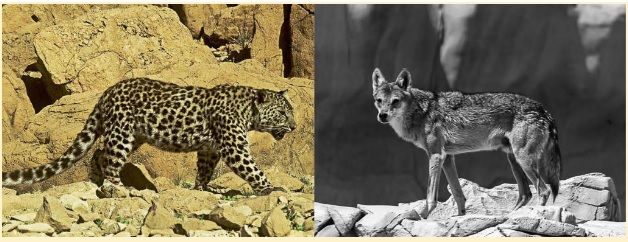Important Facts For Prelims
Arabian Leopards and Wolves
- 17 Oct 2023
- 5 min read
Why in News?
At present times, both the Arabian wolf and Arabian leopard are critically endangered, with the leopard having lost 98% of its historical range and is believed to be extinct in its northern range, including the Negev and Judaean deserts.
Dhib and Nimr: Dhib and Nimr are the Arabic terms for the two animals (wolf and leopard respectively).
What are the Characteristics of the Arabian Leopards and Wolves?
- Arabian Wolves:
- About:
- The Arabian wolf (Canis lupus arabs), is a subspecies of the gray wolf. The Arabian wolf holds the distinction of being the world's smallest wolf, making it a unique and significant part of the region's wildlife.
- Geographical Spread:
- These wolves are native to the Arabian Peninsula, including regions such as the Negev Desert in southern Israel and parts of the Middle East.
- Significance:
- In the Negev Desert and Arava Valley of southern Israel, the Arabian wolf remains a resilient apex predator, playing a vital ecological role. These wolves are adapted to life in arid environments with limited productivity.
- Arabian wolves are known to "suppress" populations of smaller canids like jackals and foxes, helping to regulate the ecosystem in the Negev Desert.
- These wolves are a crucial part of the desert ecosystem and contribute to maintaining herbivore populations and consuming carrion, which underscores their ecological importance.
- About:
- Arabian Leopards:
- About:
- The Arabian leopard (Panthera pardus nimr), is another iconic but critically endangered species native to the Arabian Peninsula. These leopards were historically found in various parts of the Arabian Peninsula, including the Negev and Judaean deserts.
- Geographical Spread:
- Unfortunately, the status of the Arabian leopard in these regions is dire. A recent study published in 2023 reported that the Arabian leopard has lost most of its historical range, and its populations have become highly isolated and fragmented.
- In the Negev and Judaean deserts, this species is considered extinct in its entire northern range.
- About:
- Conservation Efforts for Both Arabian Wolves and Leopards:
- From an ecological perspective, it would require adequate prey availability, suitable habitat, and protection from human persecution.
- However, the competition between wild and domestic prey, overgrazing of vulnerable vegetation, and conflicts with herders pose significant challenges.
- Efforts are being made to increase tolerance and coexistence with Arabian wolves, especially in pastoralist landscapes. Education about the ecological role of these wolves is being promoted.
- It is recommended to reduce hunting rates, not only of wolves but also of their prey, to support the recovery of the wolf's natural prey base.
What is the Present Context of these two animals?
- Moreover, the ongoing conflicts in the region, such as those between Israel and Palestine, could further complicate conservation efforts for the Arabian leopard.
- The response of large carnivores like leopards to armed conflicts can vary, and cooperation between different sectors is essential for successful conservation.
- Conservation efforts could potentially serve as a means to build bridges between human groups in conflict, promoting the shared conservation of natural heritage.
UPSC Civil Services Examination Previous Year Question (PYQ)
Q 1. Consider the following statements: (2019)
- Asiatic lion is naturally found in India only.
- Double-humped camel is naturally found in India only.
- One-horned rhinoceros is naturally found in India only.
Which of the statements given above is/are correct?
(a) 1 only
(b) 2 only
(c) 1 and 3 only
(d) 1, 2 and 3
Ans: (a)
Q. Which one of the following groups of animals belongs to the category of endangered species? (2012)
(a) Great Indian Bustard, Musk Deer, Red Panda and Asiatic Wild Ass
(b) Kashmir Stag, Cheetal, Blue Bull and Great Indian Bustard
(c) Snow Leopard, Swamp Deer, Rhesus Monkey and Saras (Crane)
(d) Lion-tailed Macaque, Blue Bull, Hanuman Langur and Cheetal
Ans: (a)





